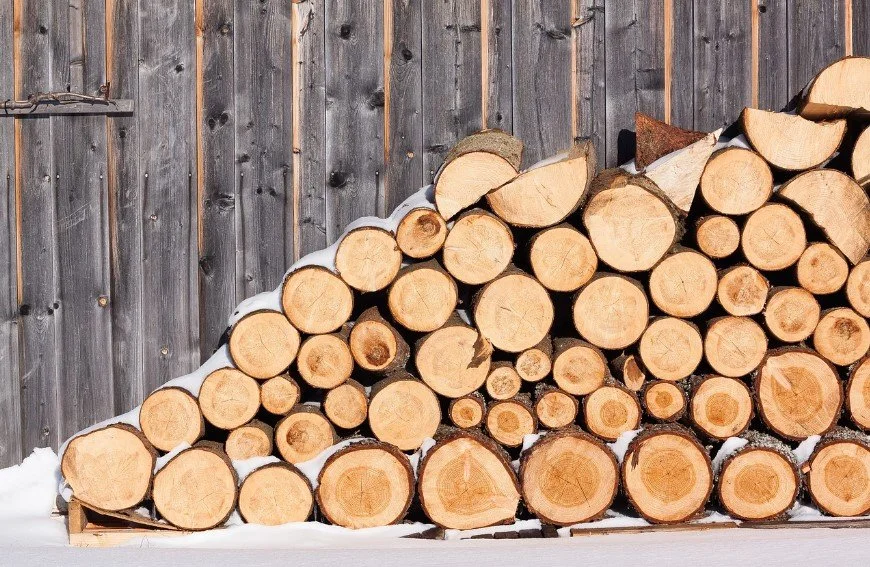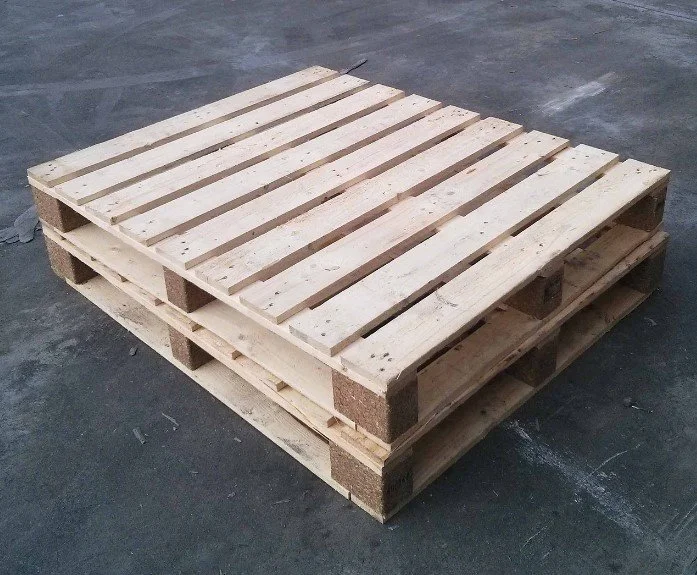I FIGURED OUT HOW TO NEVER PAY FOR WOOD AGAIN
One of the biggest obstacles to starting a new project is the cost. Time and again, I hear from my audience about how expensive wood can be. I can remember delaying many of my own projects simply because, once I added up the cost of materials, it just didn’t seem worth it anymore. So, in this article I want to talk about where you can find low-cost or even free wood for your next project. While I’m sure you’ve heard of some of these sources before, stick with me until the end because I’m sure you’ll learn about some sources you never thought of.
Firewood
Firewood is an excellent source of lumber because its price per board foot is shockingly low—sometimes even free if you find someone cutting down a tree who wants the wood hauled away.
It’s especially nice because you can control how it's cut, choosing the grain pattern (such as straight quarter-sawn grain or cathedral-like flat-sawn grain), and select the thickness of your workpieces to suit specific projects requiring larger chunks of wood.
You can cut firewood by hand, with a bandsaw, or even with a chainsaw and a jig. If the grain is straight, you can even split it into rough boards.
Firewood is ideal for small projects. I’ve made some beautiful boxes with firewood. You’d be surprised at the stunning beauty inside what initially appeared to be useless trash.
However, there are some downsides. If the wood is unseasoned, you’ll need to let your new boards dry for about a year per inch of thickness, and they may check or split in that time—potentially a problem since the chunks might already be quite short. There may also be insect damage inside the logs. All of this can add up to a great deal of waste, but the low cost will likely justify it.
Trash-Picking
If you don’t mind digging through someone else’s trash, you can find a lot of free, usable wood on trash day. Look for discarded boards or shelving. You’d be surprised what people will set by the road just to clear out their garage. Even old furniture can yield usable project wood if you’re willing to tear it apart.
If you’re really not shy, you could try dumpster diving. Over time, you’ll learn which dumpsters are more likely to yield good wood, based on the types of businesses they serve. The dumpsters behind cabinet shops are particularly promising, while those behind restaurants and grocery stores tend to be less fruitful. Just make sure you’re not trespassing on private property.
And, if you can stand the smell, the local landfill is often full of opportunities for free wood—you just have to want it badly enough.
Construction Sites
Construction sites can be a great place to get free lumber, especially small sheet goods. Depending on the project and its stage, you may also find hardwood trim and cutoffs from other high-quality boards. This applies to both residential and commercial construction sites.
But don’t just drive up to a job site and start taking things without asking, or wander into a dangerous work area. Don’t trespass after hours, either, or you could find yourself in big trouble. Ask permission and be polite. Generally, if the wood is in a trash bin, they’ll let you have it because they’ll need to pay to dispose of it anyway. Over time, you might even get on friendly terms with different crews, and they might set aside the best pieces for you.
Even if they’re hesitant to part with scraps from their good materials, they’ll almost always let you salvage debris from demolition work. Some of the best salvaged wood comes from old buildings being remodeled. You could end up with beautiful, clear old-growth beams or flooring that’s not only stunning but full of history.
Pallets
Pallet wood projects have been trendy for a while, mostly because pallet wood is cheap or even free. You can find discarded pallets on trash day or ask local businesses if they have any you can haul away. Some places that get a lot of deliveries may even beg you to take their pallets.
Unfortunately, with pallets, you never know what you’ll get. Many are made from poor-quality boards, but occasionally, you’ll find really good stuff. Look for pallets that are clean and heavy. I’ve even seen some made from walnut and exotic hardwoods. This can vary by region though, so if you find good hardwood somewhere, check back—the same mill might deliver more pallets in the future.
The greatest downside to pallet wood is the labor required to turn it into usable boards, including tearing or cutting it apart and removing all the nails. Investing in a handheld metal detector is a great idea so a hidden fastener doesn’t ruin your tools.
Additionally, some pallets may have been used to store toxic chemicals, so if it smells strange or has a lot of liquid stains, you may want to pass.
The Internet
You’d be surprised how many people have piles of boards sitting in their barns or garages since a buddy with a portable sawmill helped cut up a fallen tree years ago. Now, they just want to get rid of it. If you can buy a lot at once, you might score a really good deal. I’ve bought a lot of wood this way myself.
You’ll find these stashes advertised on sites like Craigslist or Facebook Marketplace. Search for terms like “lumber,” “slabs,” or anything else you think might show up in a listing. Be sure to ask how long the wood has been drying so you don’t end up with a bunch of green wood, and don’t pay until you’ve checked it all out and loaded it up. Sometimes, the middle of the pile could be rotten. Keep in mind that you aren’t buying from a professional hardwood dealer—people who slab their own trees often don’t know what they’re doing, so you might end up with 30-40% waste. Be sure to account for that when negotiating.
eBay can be a source of small boards, particularly highly figured or exotic woods. While they may be overpriced, you can find deals if you look hard enough. I’ve bought some great veneers for dirt-cheap prices on eBay.
Also, don’t forget you can save search terms on some of these sites, so you get notifications whenever new, relevant listings pop up. Often, it’s the early bird who gets the deal.
Yard Sales
I’ve bought a fair amount of lumber from yard sales. Sometimes it’s just a few boards left over from a project, and the seller just wants to get rid of them. Other times, it’s a pile of rough-sawn lumber stored in a barn out back.
The best part about yard sales is that folks are often willing to negotiate. If they have wood, they may also have tools, and you could bundle everything into a package deal.
Rural yard sales are often the best, especially if they’re called “barn sales” or “estate sales.” But you’d better show up early on the first day of the sale—otherwise, the good stuff might be gone.
The downsides of yard sale lumber are pretty much the same as buying lumber online.
Neighborhood Associations
If you live in the suburbs, you might find slim pickings for wood at garage sales, but many neighborhoods have internal email lists or private Facebook groups where people advertise things they wish to sell or give away. This can include excess lumber left over from home improvements or old furniture that can be salvaged for materials.
Usually, you have to live in the neighborhood to get on these lists, but you can also ask friends or family members to keep an eye out in any groups they’re part of.
Thrift Stores
Like yard sales, thrift stores often contain old furniture that could be salvaged for wood. However, I recommend a bit of caution here. Thrift stores cater to those in need, and sometimes the items in these stores are donated specifically for that purpose.
If the furniture looks like trash and has no other value, then feel free to take the wood. But if it’s a usable piece of furniture, you may not want to take it just to tear it apart for materials.
I suggest asking an employee if the item has been sitting there for a while. If it’s been around for a while with little interest, they may be eager to get rid of it.
Home Centers
While most wood at home centers is pretty expensive these days, many have clearance areas where they stack materials that aren’t fit for selling at full price. This can include damaged boards, special order items that were returned, or even open packs with missing pieces.
These clearance materials can often be had for a fraction of the regular price and may yield a lot of good wood once you cut around the damaged areas.
The challenge is finding the clearance stuff. It’s not always where you expect it to be, so be sure to ask an employee.
Local Sawyers
Most rural areas will have some sort of local sawyer. It may be a guy with a Wood-Mizer selling boards he cuts from trees that came down in storms, or it could be a larger operation sourcing logs from tree services and stocking hardwoods at much lower prices than lumberyards.
Sometimes these sawyers advertise, and you may find them on the same sites I mentioned earlier. Most often though, they do business through word of mouth. You sort of have to know someone who knows someone to get an introduction.
Don’t expect the first woodworker you meet to share their source with you. People tend to protect their suppliers. Try making friends in local woodworking guilds, or head to restaurants or bars where contractors gather. Building relationships with builders, carpenters, and cabinet makers may pay off big when they share their lumber sources with you.
Saw Mills
Large sawmills aren’t in the business of giving away lumber, but that doesn’t mean they won’t. Sometimes, they trim the ends off boards to standardize the lengths or to remove knots or blemishes. These cutoffs can be up to two feet long and are perfectly usable for small projects.
Often, someone at the mill takes this stuff home for firewood, but it’s worth asking just in case some of it goes unclaimed. You might even be able to strike a deal with whoever has laid claim to it. I once bought about three cords of walnut and maple milled cutoffs for the price of firewood.
If you’re lucky, you may even get spalted wood—what the mill considers trash but what a woodworker like you might consider treasure.
Conclusion
Keep in mind that nothing in life is truly free. If you want to save money, you’ll need to invest time and effort searching for low-cost materials or working to make them usable.
Some people might argue that time is money—so are you really saving that much? Maybe, but not for everyone. Time is only worth money if someone is paying you for it. If you have spare time on your hands, consider trying some of these methods to save money on wood for your next project.
★SOME OF MY FAVORITE INEXPENSIVE TOOLS★
#ISOtunes Hearing Protection (Save 10%): https://bit.ly/3BHYdH7
BOW Featherboards: https://amzn.to/430ldhv
123 Blocks: https://lddy.no/vpij
-Mechanical Pencils: https://amzn.to/2PA7bwK
-Lumber pencil: https://amzn.to/2QtwZjv
-Pocket Measuring Tape: http://amzn.to/2kNTlI9
-Nut/Bolt/Screw Gauge: http://amzn.to/2CuvxSK
-Self-Centering Bits: https://amzn.to/2xs71UW
-Steel Ruler: https://lddy.no/10mv7
-Center-Finding Ruler: https://lddy.no/10nak
-Bit & Blade Cleaner: https://amzn.to/2TfvEOI
-Narex Chisels: https://lddy.no/sqm3
-Mini Pull Saw: https://amzn.to/2UEHBz6
-Shinwa Rulers: https://lddy.no/zl13
(If you use one of the affiliate links above, we may receive a small commission)



